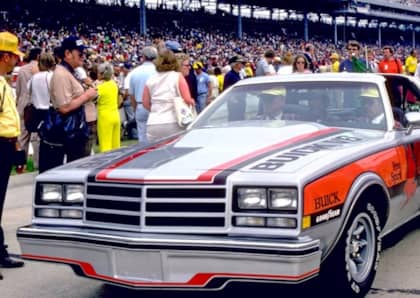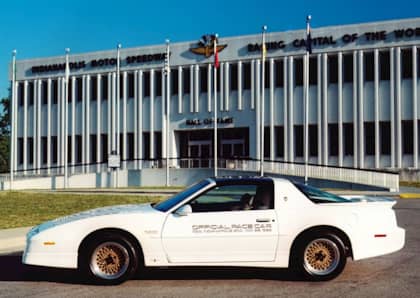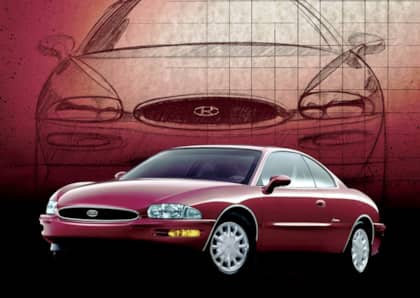History Of The Turbocharged Buick 3.8L V6, GM's Mightiest '80s Muscle Car Motor
The story of the Buick Grand National (and its hopped-up sibling, the GNX) is a familiar one to muscle car fans: in the early '80s Buick took its Regal coupe, outfitted it with a turbocharged V6, and proceeded to stomp all over every other American car in a straight line. This included the Corvette, which was reduced to playing second fiddle alongside the GNX until it left the market after 1987.

The history of Buick's focus on turbocharged V6 engines, however, goes much deeper than the Grand National and its siblings, and starts earlier than the revised Regal's debut. The GM brand was at the vanguard of the turbo revolution that dominated much of the '80s performance landscape, and it spread its boost through a surprisingly wide swathe of its line-up.
Indy 500 Leads The Charge
It all began in the mid-1970s when Buick was offered the chance to pace the Indy 500. This was a tall order in an era when General Motors had smog-choked most of its V8 engines to the sub-200hp level, and the automaker had get creative to come up with a car that could stay ahead of an open-wheel racer until the green flag was waved. Although for 1975 Buick simply threw cubic inches at the problem (outfitting its mid-size Century sedan with a 455 cubic inch V8 that was decidedly hotter than stock), the following year it decided to innovate.

This time, it took a 3.8L V6 and installed a draw-through turbocharger that worked with its four-barrel carburetor to stuff a whopping 22 psi into the motor. Running at a mere 6.0:1 compression, the setup was good for a healthy 306hp and 370 lb-ft of torque, and marked the first time a six-cylinder engine had ever been used to pace America's race. Buick offered a pace car replica in dealerships, but the factory Century stuck with a V8 as the turbo used at Indy was deemed too exotic for the street. It wouldn't be until 1978 that the initial turbocharged Buicks began to trickle out into dealerships.
Luxury And Power
The first Buick turbos were more modest than the designs that had lapped Indianapolis. Horsepower was cut nearly in half, checking in at 165 ponies for four-barrel models, as a result of an increase in engine compression (8.0:1) and a related drop in boost (a more reasonable 6 pounds from a T3). Torque approached V8 levels, however, with 285 lb-ft available. GM was also experimenting with electronic knock control, which relied on sensors to claw back ignition timing if detonation was detected.

The turbocharged V6 was initially installed in the Regal and Lesabre 'Sport Coupes,' which represented half of all turbo cars on the market at that time (with the Saab 99 Turbo and the Porsche 911 Turbo filling out the roster). By 1979 the Buick family added another pair of models (the Century and the Riviera), featuring new cylinder heads that added five horsepower into the mix for Regals and LeSabres, 10 extra for the Century, and 20 more for the Riviera (thanks in large part to better exhaust routing on the bigger cars). Torque fell slightly to 265 lb-ft for the smaller cars, with the Riviera leading the pack at 280 lb-ft.

Chevrolet borrowed the Buick V6 turbo for the G-body Monte Carlo in 1980 and 1981 (selling a respectable 20,000 units) but by '82 the family of turbos was pared down to just the Regal and the front-wheel drive Riviera (both known as the T-Type since the previous year), presenting two very different driving experiences. In 1983, the final year of the first-generation Buick turbo V6, the luxury-oriented cruiser peaked its torque at 290 lb-ft, with horsepower for both models checking in at 180.
Fuel Injection Changes Everything
1984 proved to be the most important year for the 3.8L turbo V6, as it marked the move to sequential fuel injection. The difference in output figures was immediate: 200 horses and 300 lb-ft of twist were now standard. Even more important, however, was the vastly improved ignition system which could more closely control the marriage of boost and fuel delivery, and allowed the use of up to 12 psi from the turbo. This improved reliability and tunability, making the Regal a stealthy choice for performance fans who craved a bit of comfort in their daily driver.

It's here that that Grand National trim of the Regal came into the popular consciousness. Although the name had been introduced for a very limited run in 1982 (with just over 200 units being sold in two-tone gray), by '84 the decision was made to go all-in with a blacked-out Grand National as the range-topper for the Regal line. The car was shockingly quick, easily besting Mustang and Camaro V8s of the day despite its larger size, and it nipped at the heels of the much more expensive Corvette.

Two years later, the Regal sharpened its talons even further thanks to the use of an intercooler, which bumped horsepower to 235 and increased torque to a healthy 330 lb-ft, earning the V6 engine a new name (the LC2). By this time the Riviera had switched platforms, which made Buick's rear-wheel drive mid-size coupe the only turbo game in town.

Buyers could choose from T-Type, Grand National, and for 1987 only, WE4 (a lightweight model known as the Turbo T with an aluminum turbo housing) and GNX versions of the car, each of which could happily spin the rear wheels. The T-Type was also renamed the T-Package for '87.

The GNX was a true monster, offering up 276hp and 360 lb-ft of torque thanks to the presence of an improved Garret T3 turbo producing 15 psi of boost, a massive intercooler, more aggressive engine controls, a free-flowing exhaust system, and upgraded suspension and transmission details.

The GNX was identified through its mesh wheels and badge-deletes, and the interior included a dash plaque that let you know which of the 547 examples you happened to be driving. The car could hit 60 mph in just over four and a half seconds, and was easily the quickest American vehicle of its day.
Pontiac Borrows A Beast
For 1988, the Buick Regal went the route of the Riviera before it and transitioned to a new platform (also front-wheel drive) that left the 3.8 turbo V6 on the shelf. Still, the motor itself had one last shot at dazzling muscle car fans when it appeared between the front fenders of the 1989 Pontiac 20th Anniversary Turbo Trans Am.

Featuring a set of different heads and stronger internals, the revised LC2 engine in the Trans Am produced more than its advertised 250hp and 340 lb-ft of torque (with boost having been raised to a 16 psi). The coupe boasted a quarter mile time in the lower reaches of the 13 second mark.

Only a few thousand of these vehicles were built, largely to use up 3.8L V6 engines sitting in Buick's warehouse. It was to be the final hurrah for an engine that had been turning heads and snapping necks among Buick fans for two decades, and it marked the last time that GM offered a turbocharged passenger car for nearly 15 years.
More From Driving Line
- Want more details about turbo Buicks outside the Grand National's influence? Check out these alternative Buick muscle machines that rocked a turbo mojo.











